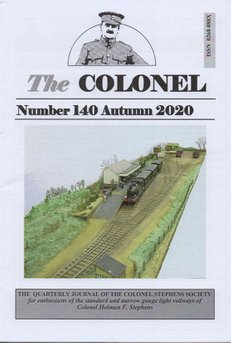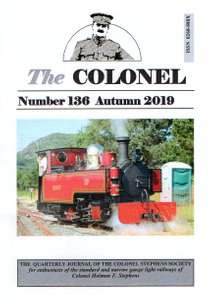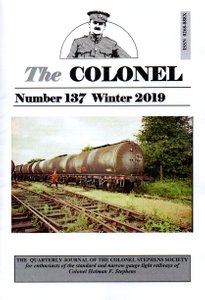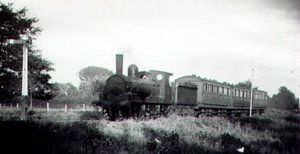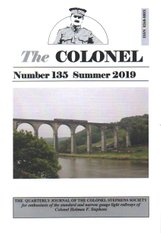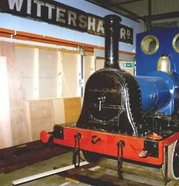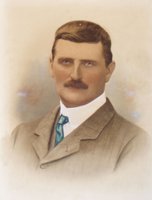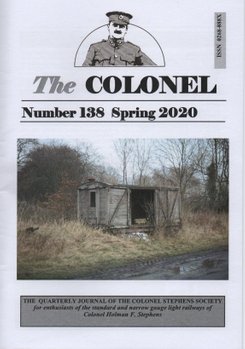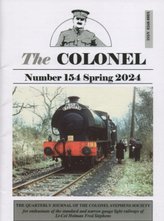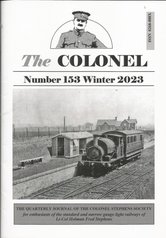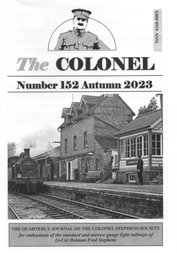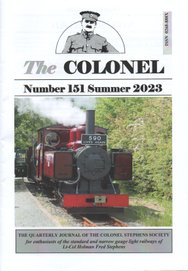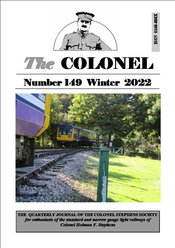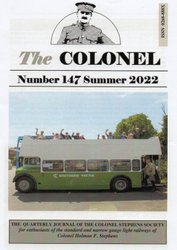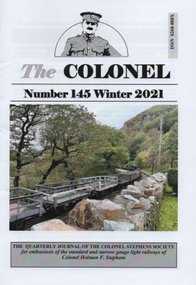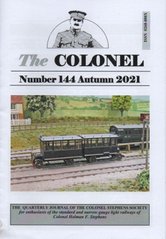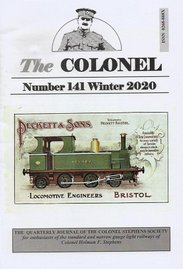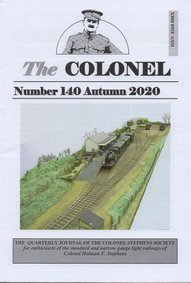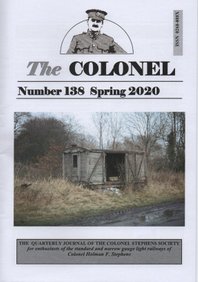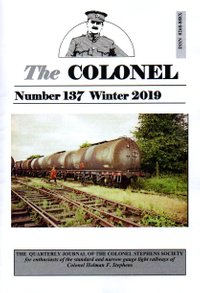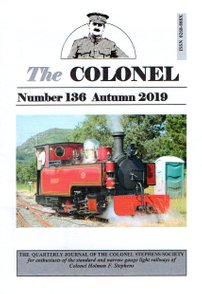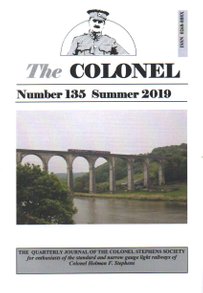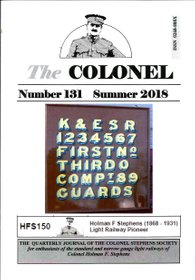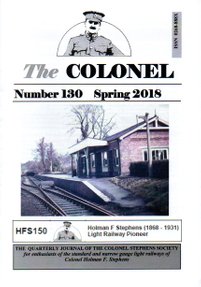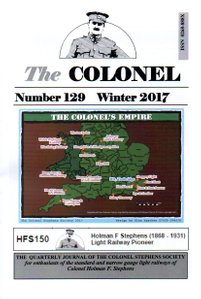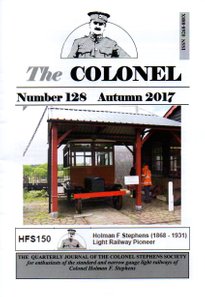'The Colonel' is an informative journal containing, News, Reviews, Reports and articles about the life and times of Colonel Holman Fred Stephens and the railways he was involved with. It is produced quarterly and delived free to members of the 'Colonel Stephens Society' |
The Colonel - Journal of the Colonel Stephens Society
The Colonel 154
Spring 2024
The Colonel 153
Winter 2023
The Colonel 152
Autumn 2023
The Colonel 151
Summer 2023
The Colonel 150
Spring 2023
The Colonel 149
Winter 2022
The Colonel 148
Autumn 2022
The Colonel 147
Summer 2022
The Colonel 146
"Spring 2022
The Colonel 145
Winter 2021
The Colonel 144
Autumn 2021
The Colonel 143
Summer 2021
The Colonel 142
Spring 2021
The Colonel 141
Winter 2020
The Colonel 140
Autumn 2020
The Colonel 139
Summer 2020
The Colonel 138
Spring 2020
The Colonel 137
Winter 2019
The Colonel 136
Autumn 2019
The Colonel 135
Summer 2019
The Colonel 134
Spring 2019
The Colonel 133
Winter 2018
The Colonel 132
Autumn 2018
The Colonel 131
Summer 2018
The Colonel 130
Spring 2018
The Colonel 129
Winter 2017
The Colonel 128
Autumn 2017
Comming soon
Colonel 153 should be with members now. Two interesting vintage photos are on the front and rear covers featuring the East Kent and the Rother Valley railways. As well as the usual current news, modelling notes and letters; the Zoom meetings about the Sierra Leone Railways and the Edge Hill Light Railway are summarised. There are updates of new and revised exhibits at the Colonel Stephens Railway Museum at Tenterden and Bob Clifford does some detective work about a first class pass issued by the K&ESR to one Ben Howse. Stephens’ offices at 23 Salford Terrace Tonbridge has now been converted to flats after the previous owner died. Leon Coast writes about the Revd. Brock of Criggion; who famously wrote to the Board of Trade complaining about his trip from Kinnerley to Criggion in the open rear section of Gazelle. Howard Carey, son of one of the WC&PR’s guards, provides some captions to some vintage photos of the line. Brian James discusses the use by the Southern Railway of the K&ESR’s large white elephant, the 0-8-0T Hecate. Allen Morgan relates his Light Railway modelling career and ‘Blast’s from the Past’ has a succinct history of the Callington Branch. Book Reviews include the highly recommended ‘Colonel Stephens Light Railway Locomotives’ by Brian Janes from Pen & Sword. Nigel Bird has copies! Another book review is about LSWR loco engineer William Adams.
Colonel 152 for Autumn 2023 contains the usual features of news about Colonel related lines, the latest developments at the Colonel Stephens Railway Museum at Tenterden and Modelling Notes. Also featured are snippets of Stephens related items in the railway press plus several letters in “Dispatches”. Society News reminds members to renew their subscriptions and says the AGM will take place at Shrewsbury Abbey Station (the terminus of the Shropshire and Montgomeryshire Railway) on May 18th-19th 2024.
“Blasts from the Past” features the East Kent’s Richborough branch and testing a “Super Sentinel” loco on the S&M in 1928. The new interpretation boards for Shrewsbury Abbey station are shown, explaining the complex history of the S&M, the “Potts” as it was known locally.
Dana Wiffen relates his ramble over the remains of the Rye and Camber Railway and Ralph Gillam’s “Zoom” talk on his trip over the East Kent Railway just before closure is summarised. There is a lovely copy of the painting of a moment on the trip when they passed a picnic party. Ralph had this painting commissioned by railway artist Matt Cousins. Copies can be obtained of this evocative picture.
Brian Janes reflects on the centenary of the opening of the Welsh Highland Railway with a brief history of its origins, Stephens’ involvement and the background to its closure in 1936. Stephen Poole recounts how he became a fan of Stephens’ railways in his teens, leading to researching them over many years and a career on the “big railway”. With the recent visit of a “Battle of Britain” pacific to the K&ESR, Ross Shimmon looks at other large locos that have visited the line over the years from 1904 when the 0-8-0T “Hecate” arrived until modern times.
Finally two books – “Lost Railways of the World” and “Hunslet Locomotives Preserved” are reviewed by Dana Wiffen.
New editor Chris Jackson has got off to a cracking start with the latest edition of the ‘Colonel’ which is currently being delivered to members. Whilst the AGM weekend features strongly, there are articles on Ralph Gillam’s about his trip over the East Kent Railway shortly before passenger services ceased and much of the line was shut. Tom Burnham discusses the K&ESR’s 1909 service of same-day delivery for orders from Tenterden sent by train to wholesalers in Maidstone and returned by train and delivered that evening.
The AGM weekend includes reports on our visit to Beamish and Tanfield as well as the AGM. Visits by some members to the Bowes, and Wear Valley Railways also are mentioned. The main news items are the approval of the Rother Valley’s long delayed application to complete the line through to Robertsbridge and the return to steam on the Welsh Highland Railway of the First World War vintage Baldwin 4-6-0T that has been under restoration for some years, a job supported by the Society. Of course there are all the other news items too.
‘Blasts from the Past’ explores the story of K&ESR No. 8, the fate of the two WC&PR ‘Terriers’ taken over by the GWR in 1940 and Dean Goods taken over by the army in 1939 and used on several Colonel lines. Jon Clarke concludes his eight part article on private owner wagons recorded on the Shropshire and Montgomeryshire Railway while two new books are reviewed.
Colonel 150, As well as the usual news features this issue contains the Agenda for the AGM in May, the Society’s officer’s annual reports and a booking form for the AGM weekend at Beamish, Tanfield and Bowes. Brian Janes provides an article on the Corringham Light Railway, Jon Clarke continues his series of articles on the private owner wagons found on the Shropshire and Montgomeryshire Railway with part seven. Steve Bell provides a 1900 newspaper clipping about the Tanat Valley Light Railway and its possible boost to reopening the derelict line from Llanymynech to Shrewsbury. This became the Shropshire and Montgomeryshire Railway, which finally reopened in 1911.
Neil Burgess provides a response to the article by Brian Janes in Colonel 149 on the effect of the 1920s grouping of the major British railways on Light Railways. The editor indulges his interest in the Bishop’s Castle Railway with some photos of its last days in 1935-36 and some of the trackbed which forms part of the Onny Trail near Craven Arms.
Ian Dack has found a fascinating article in a 2000 “Steam World” magazine on the ex-Southern Railway “Camelback” 0-6-0ST that were used on the East Kent and K&ES railways. A new book on the little Blaenau and Festiniog Railway is reviewed.
Colonel 149 contains all the usual articles of news and events on the railways connected with the Colonel. Articles consider the passenger trailers provided for “Gazelle” and more private owner wagons known to have appeared on the Shropshire and Montgomeryshire Railway, the last train to Robertsbridge which collected remaining stock at Robertsbridge prior to the line being severed in 1972, the fate of A1 Terrier “Daphne” and why Stephens’ railways weren’t grouped in 1923. There is a reprint of a 1935 letter in the Meccano magazine about a visit to the Rye and Camber Railway, recent acquisitions at the Colonel Stephens Railway Museum at Tenterden, photos of layouts at the Portishead show plus reviews of new books concerning the K&ESR by Brian Janes and Aeromotor Windmills (bought by the Colonel to pump water at several of his railways). The fate of Weston, Clevedon and Portishead’s Loco No. 5 after closure in 1940 is revealed by Howard Carey.
Colonel 148 contains the usual mix of articles. There are the regular “News and Events”, “Press Digest” and three book reviews. Howard Carey writes a fascinating account about his memories of the WC&P’s Conygar and Black Rock quarries in the 1930s and 40s. The guest railway is the Talyllyn, with a brief history of how it came to be preserved. Les Darbyshire provides some photographs of the Isle of Wight Railways in the 1970s, while Jon Clarke continues with part five of his series on private owner wagons seen on the “Potts” – the Shropshire and Montgomeryshire Railway. Brian Janes recounts the long history of a “Potts” wagon and also reviews the numerous types of single line working employed on the Colonel’s railways. “Dispatches” has letters about the BP&GVR wagon label, the Hawkhurst branch bus services and the last days of a former Garstang and Knott End Railway coach.
Albyn Austin, Hon. Editor
Colonel 147 has articles concerned with the AGM weekend. There are brief histories of the Selsey Tramway and the Isle of Wight Railways. There follows articles about the walk following the trackbed of the Selsey, the Society AGM and the visit to the Isle of Wight Steam Railway. It includes a ride on the rebuilt Drewry Ryde Pier Tramway car and the visit on Sunday to Brading Station museum. There is the next part of Jon Clarke’s series on private owner wagons used on the Shropshire and the Montgomeryshire Railway. Also there are the usual features of News and Events, Dispatches, Press Digest and a Book Review of “Unfinished Lines”. Finally there are a few extra snippets including a very unusual wagon label from the Burry Port and Gwendraeth Valley.
The cover of Colonel 146 shows Saint Michael’s tunnel on the KESR just outside Tenterden. Inside the Colonel includes all the usual features of news and letters from members. There are the officers’ reports for the AGM in May and details of the AGM weekend at Selsey and on the Isle of Wight. Articles include a profile on William Austen – Stephens’ chief assistant and successor after his death, there is a 1961 trip from Robertsbridge to Tenterden in a goods brake van behind a diesel powered goods train a month before the line closed. There is an account of the coal and mineral business of the Weston, Clevedon and Portishead with details of the quarries and their locomotives. Jon Clarke continues his articles on Shropshire and Montgomery Railway private owner wagons with details of the domestic coal wagons from Welsh collieries. On the subject of coal there is a breakdown of the coal wagons received at Tenterden in 1904-6 from a surviving ledger – fascinating details of where the coal came from and who supplied it. There is a book review on “Engineering Richborough” the story of Richborough port with its connection to the East Kent Railway. Finally there is an article on the names of the locomotives on Stephens’ railways and the location of the surviving nameplates. All this for a tenner a year for four issues plus our monthly Zoom lectures and annual AGM weekends.
The cover of Colonel 145 shows a demonstration gravity slate train on the Ffestiniog Railway during their October 2021 vintage weekend. Inside the Colonel includes all the usual features of news and letters from members. Articles include the use of the K&ESR’s Pickering steam railcar on regular service trains, a note on permanent speed restrictions on the K&ESR in BR days and a last word on the location of Selsey driver Tim Johnson’s home in Selsey. ‘Blast from the Past’ includes a walk along the WC&P after closure, two trips over the K&ESR in 1947 and 1954, and a 1932 visit to the Selsey tramway. There is a note on Shapeways’ 3D printed coaches and wagons for the Rye and Camber Railway. Jon Clarke continues his articles on Shropshire and Montgomery Railway private owner wagons with details of the wagons from Welsh collieries which supplied the railway with loco coal. Bob Clifford looks at the teenage Stephens summer visit to Germany in 1886, through the letters he sent to his parents. Ralph Gillam adds some extra information on the East Kent Railway missed by the recent book on the railway. Howard Carey provides captions to some photographs of the WC&PR, while we finish with a short article on the Garstang and Knott End Railway. All this for a tenner a year for four issues plus our monthly Zoom lectures and annual AGM weekends. For this year’s AGM in May, it is proposed to visit the remains of the Selsey tramway and the preserved portion of the Isle of Wight Central Railway on which Stephens briefly served as chief engineer.
In Colonel 144 Les Darbyshire summarises his talk about his model railway layout “Maidstone Road” and David Powell writes about his talk on the early professional career of Stephens. Other articles cover new museum acquisitions:- letters from the parish council about the building of Hole station on the North Devon and Cornwall Junction Railway plus some photos of the rebuilding of Torrington viaduct for the ND&CJR. A new book on the East Kent Railway is reviewed, plus an article on EKR wartime passenger numbers and another piece of paper found in the hut at Shepherdswell in 1948. Dana Wiffen lists all the Societies connected with Stephens’ railways. There is a discussion of a letter which provide the background to Stephens’ likely involvement with the BCR. The story of another minor railway, the Rowrah and Kelton Fell, is summarised and society co-founder Jon Clarke writes about the private owner quarry wagons that worked over the Shropshire and Montgomeryshire railway.
We also include the usual news from Stephens related railways, Society news including future Zoom talks, some modelling notes and letters to Dispatches. All in all this is another interesting issue of the Colonel.
Colonel 143 has an account of the virtual AGM this year using a live Zoom meeting. This went off well with 25 participants. Read about it in Society News. As the Society intends to host monthly Zoom meetings I have included a few photos of Les Darbyshire’s famous model railway layout “Maidstone Road” that will feature in our second talk. David Powell will use the first one to talk about the early professional career of Stephens. If you’re interested join the Society!
The North Devon and Cornwall Junction Railway makes rare appearances in this issue and the old East Kent Railway gets some coverage too. As most of the membership seems interested in other minor and light railways, I have kicked things off with a short history of the Cleobury Mortimer and Ditton Priors Light Railway. This was one of the few which became a modest success story because of its mineral traffic. It was quickly grouped by the GWR, unlike the Bishop’s Castle for instance. When the mineral traffic finished it nearly closed, but was saved by the Admiralty building a war time ammunition depot which ensured it continued to operate until 1965 when it was the last Light Railway still operating independent from British Railways with its full 12 miles length of track still in use. Oakwood Press have a line history.
We look at the growth of road traffic in the 20th century which impacted dramatically on most branch line railways. Also how the rapid increase in houses with electricity in the 1930s provided the opportunity for small scale electric model railways. We also include the usual news from Stephens related railways, Society news including the Zoom AGM, some extensive modelling notes and letters to Dispatches. All in all another interesting issue of the Colonel.
Colonel 142 has a personal recollection of a trip on the Selsey Tramway, the North Staffordshire Railway’s interest in rebuilding what later became the Shropshire and Montgomeryshire Railway, some notes on an East Kent Railway apprentice, a new book on the origins of the Kent and East Sussex Railway- “Change at Robertsbridge” by David Penn and the unsuccessful attempts to save the two veteran Royal Saloons owned by the K&ESR and S&MR. There is a fascinating 1920s aerial view of Chichester showing the Selsey tramway station plus the usual news from Stephens related railways, Society news including the committee’s reports for the AGM, a Zoom meeting being planned for this plus some on-line talks; and some extensive modelling notes and letters to Dispatches. All in all another interesting issue of the Colonel.
Colonel 141 has the usual features of preservation news, new model railway items and summaries of some of the preservation societies’ magazines. Sadly six members were reported as dying in the last year and we include two obituaries. Alan Cliff, a retired Methodist minister, Bala Lake Railway supporter and prolific author is probably best known for his “Jack the Station Cat” books. Bob Alderman worked in aircraft design but was a first class 7mm modeller who built a beautiful model of a Ford Railcar that featured in Colonel 122 amongst many other achievements.
The cover features a post card of the Peckett 2-4-2T built for the Selsey tramway, specially produced for the company in 1905. The 1994 sale advert of the house lived in by former Selsey driver Tim Johnson is also featured. An article cover events at Salford Terrace during the months before Colonel Stephens’ death in 1931. Another is of memories of two trips over the ND&CJR, the Southern Railway’s last light railway built by the Colonel, just before its closure in 1964 and 1965. A 1915 wagon census form for the K&ESR is discussed and so is the background to Hamilton Ellis’s picture of an Ilfracombe goods loco at the S&M’s Shrewsbury Abbey station in 1912.
Book reviews cover “The King of Light Railways”, “The East Kent and Knees Woodland Railways and lists Colonel related books by other publishers. The committee agrees that non-Stephens railways will be covered occasionally as space permits. Dispatches discusses including non-Stephens material, the livery colour of Selsey coaches and some YouTube references to films of the Selsey Tramway. Other articles cover a forgotten Stephens’ petrol locomotive experiment, through tickets from London to Selsey by the LBSCR via the Selsey Tramway and Nesscliff station on the “Potts” (the S&MR). Hopefully members will enjoy this issue and this synopsis may attract some new members.
I hope everybody is well and not too frustrated by the current situation. I seem to have been as busy as ever but have managed to get a bit of railway modelling done before the garden, house maintenance and the Colonel etc started to take up my time.
I think we have quite a varied Colonel this time with a couple of articles on the Selsey tramway, a newspaper cutting advertising for a conductor on the Rye and Camber, a couple of articles on the K&ESR plus a review of the new Rails “Terrier” and a couple of articles on model railways. There are some more recent photos of the caustic soda tank train at Folly Lane Sidings, Weston Point Light Railway at Runcorn and a long article on JC Buckwell, a proponent of Light Railways in Kent and Surrey. The old Wolseley Siddeley railcar body once at Kinnerley features on the rear cover plus a couple of interesting old photos inside. Of course there are the usual features on the current scene—not a happy situation for preserved railways. They are gradually reopening but with limited services and limited revenues. Try to support them if you can, though most of us are in the high risk age group!
There is also a letter suggesting extending the coverage of the Colonel to all the small independent railways pre-nationalisation and asking for comments.
Nothing to do with Colonel Stephens but I was entertained for five minutes by this whimsical youtube video shot in the lockdown. Try opening youtube and searching for Sheffield Riviera Express. Searching for the link https://www.youtube.com/watch?v=5eH8dyPAc3k may also work if you can be bothered
This issue coincides with the closure of the Weston, Clevedon and Portishead Railway 80 years ago in 1940. The Weston to Clevedon section only opened in 1897 and the line to Portishead only in 1907, so the northern section only lasted 33 years. Thus this issue has rather a WC&PR flavour. Howard Carey, son of WC&PR guard Dan Carey provides us with two articles. He recalls the final days of the WC&P and the second is a general chat about his memories of the line with a final excursion into his career on British Railways. We have some WC&P timetables from the later years plus some photos. Other articles cover a visit early in the year to the remains of the Weston Point Railway at Runcorn and the development of Tenterden Town station on the K&ESR. All this and the usual Society news, modelling notes, letters and press digest. As the AGM has been cancelled this year we also include a virtual AGM with full transcripts of officers reports plus instructions about the proposed minor changes to the constitution.
Colonel 138 includes some articles on topics rarely covered in the Colonels. As well as all the usual features there are photos of some unusual tickets and an all line pass for the Colonel’s railways. There is news from the Gwendraeth Valley railway, several features on the Shropshire and Montgomeryshire Railway- Locos used by the War Dept, some 1981 colour photos, an unusual stock consignment and the obituary of James Ramsay who was chairman and managing director in the 1930s. There is a personal account of a trip on the Sheppey Light Railway with a brief history and description. Book reviews cover one on the 1896 Light Railways Act and a new book on the Bishop’s Castle Railway. There are articles on the staffing and pay of the K&ESR on the eve of nationalisation and some photos of a recently restored Great Eastern Railway Brake Third similar to one used on the K&ESR.
The winter edition of the Colonel includes all the usual features and is now in full colour. Members are reminded that this will be their last magazine unless they renew their £10 annual membership! In the News section it is reported that the East Kent Railway has suffered a damaging arson attack. There are updates on the KS4415 and Drewry railcar restoration projects, happenings on the K&ESR, the WHR/FR, the proposed Tarka line, The Colonel Stephens museum, the proposed cycleway along part of the WC&PR, the WC&PR Group’s new book, their new Christmas card and the small exhibition on the railway at Weston museum.
Details of the AGM weekend next June at Beamish are given. Articles include photos and a description of the last days of the oil depot at Shrewsbury “Potts” station, pay and staff on the K&ESR in 1945, the “S” scale layout “Arcadia”, the takeover by the EKR in 1916 of the part-built railway, the story of Captain Cloutman – a colleague of the Colonel and a review of the WC&PR Railway Group’s new book on the railway “Then and Now”. There are lots of letters and lots of news of new model railway items for the Colonel’s lines plus a review of Hornby’s new “Terrier” loco in 4mm scale in comparison to the old Dapol/Hornby one.
Hopefully something for everybody and well worth the annual subscription!
Colonel 136 is the first one to be printed entirely in colour, though of course many of the old photos are still in black and white! As well as the usual features there is part 1 of an article on the surviving Stephens’ family correspondence concerning the young HFS from his birth onwards. Ralph Gillam remembers a 1958 Stephenson Locomotive Society trip over the soon to be closed Shropshire and Montgomeryshire Railway (S&M). Ross Shimmon reviews a new book on the Festiniog Railway’s locomotives. There is brief summary of the history of the Corringham Railway, more photos showing the likely origin of the S&M’s locomotive “Severn” and some notes on the remains of the FR’s Dinas branch at Blaenau Ffestiniog. Lots more items cover many topics related to the Stephens’ railways.
Colonel 135 has all the usual features. The 2019 AGM is reported as well as our activities over the AGM weekend. Ralph Gillam remembers a later trip to Tollesbury and confirms that EKR coach 10 finished up at Selhurst depot. The editor finds out what a challenge Stephens faced in converting the narrow gauge East Cornwall Mineral Railway to Calstock Quay into a standard gauge branch line from Bere Alston. Bob Clifford relates that Stephens stored a veritable arsenal of firearms at his parents’ house. Brian Janes provides the background to the building of the Rother Valley Railway and also gives the most likely history of the Shropshire and Montgomeryshire’s veteran locomotive “Severn”.
I hope you enjoy this issue of the Colonel. Two new books both authored by Brian Janes are reviewed in this issue and featured on the cover. Inside Howard Carey provides another of his fascinating articles on the Weston, Clevedon and Portishead Railway with some useful information for modellers on the seating arrangements in the small Drewry No. 1 railcar and the trailer which was used for both railcars.
There are four different accounts of the origins of the Shropshire and Montgomeryshire’s elderly saddle tank “Severn” from various books. In the next issue Brian Janes will publish the results of his investigations into its origins.
Still talking about the “Potts”, Blasts from the Past summarises two articles. The first concerns the story of the three ex LNWR “Coal” engines that worked most of the traffic in the 1930s. The second covers a 1931 visit that finished with a high speed run in the Ford railcars in order to make a connection at Llanymynech.
Ralph Gillam provides another fascinating account of his first visit to Shepherdswell in 1948, just after nationalisation had occurred, with details of the deserted site that he wandered over before the train crew returned from the pub!
“Press Digest” includes more information on Ffestiniog signalling, the state of the track in the 1960s. Why were the curves so heavily canted? The stock of the original Festiniog Railway wagons is reviewed. “Dispatches” mentions other little railways in Essex. Was the young Stephens inspired by France’s secondary railways during his stay in France? Was the new railmotor book rushed? Should we have more drawings of Stephens’ railway stock?
We also have our regular features of news, railway modelling developments and Society news. This includes details of the AGM weekend activities based at Bere Ferrers at the start of the Gunnislake branch – the last Stephens line still running a passenger service on the national network.
The colour photos include recent views of Shrewsbury Abbey station, Stephens’ birthplace at Hammersmith Terrace, blue diesels at Weston Point and on the rear cover two more 1960s photos from Tom Burnham.
Colonel 133 includes our usual round up of news both in the Society and the wider world of Stephens’ railways. It is 150 years since his birth but I’m sure he, and the Salford Terrace staff, would be delighted that his railways are still remembered and that even in 2018 parts of them are still running.
In this issue Brian Janes sorts out the very complicated story of Rother Valley and K&ESR coaches prior to 1914, while Richard Barton describes how he built an RVR rake of coaches from etched brass and plasticard. “Blasts from the Past” features a cache of early 1950s Drawings of Stephens’ stock in the “Model Maker” magazine discovered by Ian Cross. Brian Janes has also found a possible new loco that ran on the WC&PR—see “The Mysterious Hecate” on page 27. There is also an account of the teenage Stephens stay in France and the usual interesting letter and emails in Dispatches.
There are also some photos of Howard Carey’s Weston, Clevedon and Portishead Railway collection of fascinating paperwork and memorabilia. There are several book reviews including the new and much enlarged edition of the book on Colonel Stephens’ Railmotor available to members at a reduced price from Nigel Bird.
Colonel 132’s cover features the blue plaque to commemorate Colonel Stephens recently erected at Tonbridge station. There is more about the event inside. Besides our usual features Ralph Gillam concludes his story of a 1950 coach trip with a visit to the Kelvedon and Tollesbury Light Railway, where he rode in the former Wisbech and Upwell tram car. There is a feature on the early Great Eastern coaches, bought bythe Rother Valley Railway, and the Pickering specification for the three bogie carriages supplied to the Kent and East Sussex Railway in 1905. Were the third class seats arranged longitudinally along the coach walls or were they the usual two plus two type with a central gangway? Both options were offered. “Press Digest” includes more information on Ffestiniog signalling in the 19th and 20th century. “Dispatches” adds more information on Ford railcar gearboxes and confirms that the giant “Boche-Buster” gun did reach Halwill Junction at the end of the North Devon &Cornwall Railway, but probably never ran over the line. However it was briefly stationed on the East Kent Railway. A photo of the 1978 staff reunion of Stephens’
surviving staff and its accompanying letter makes interesting reading. There are someinteresting photos of the WC&PR with a thought on what traffic might have been intended for Wick Saint Lawrence wharf. The book of the diaries of the Southern Railway’s Gilbert Szlumper and Leo Amery is reviewed as is one on Sebastian Meyer, the “Light Railway King of the North”, hardly remembered today, but a man who built nearly as many light railways as the Colonel. Finally the back cover has
two evocative colour photos from the 1960s of Fallgate Quarry, the last vestige of the Ashover Light Railway
Colonel 131 features an account of the AGM and the AGM weekend activities. The cover portrays the latest museum acquisition, a set of K&ESR coach transfers, rather elaborately shaded. Other features include a list of the Colonel’s unfulfilled schemes and some more WC&PR photos with comments from Howard Carey, the son of one of the guards. Modelling notes has lots to report- an OO “P” Class and a new proposal for an OO “Terrier” plus 3D body models of various Stephens’ prototypes. “Blasts from the Past” records a proposed Hunslet steam railmotor for the Westward Ho and Appledore Railway, while Ralph Gillam recalls a 1950 coach trip to visit the Coryton Light Railway. There is a 1979 obituary of Arthur Iggulden, Stephens’ railways accountant, and a 1917 timetable for the East Kent Railway. All this plus the latest news from the various Stephens connected railways and restoration projects, Press Digest of articles about Stephens’ railways and Dispatches which includes a letter on “Boche Buster” the 18” howitzer used in Kent to deter a Nazi invasion in 1940, being based on the North Devon & Cornwall Junction Railway where it fired at least one shell onto Dartmoor. The editor doubts this but has since found he was wrong! See the next Colonel for the full story
Colonel 130 seems to mention most of the Colonel’s railways. As well as the usual News section, AGM details etc there is an article by Andy Probyn of Maxitrack of his connection with Stephens’ railways. In particular he knew Bill Austen Junior through their common interest in model engineering. There is a colour photo of Bill Austen Junior in the centre pages. Chris Grove of the Tamar Belle discusses the Colonel’s dealing with Cornwall and locos with connections to Cornwall. An article features Crich Tramway museum’s near derelict London horse tram body that seems very similar to “Gazelle’s” horse tram trailer. Modelling Notes has a WC&PR bias but Press Digest has a nice photo of a calf being unloaded from the trailer of the Selsey Tramway. There are obituaries of two former CS members – John Spencer and Richard Casserley. The Ffestiniog Railway Heritage Journal features an article on therailway’s connection with the armed forces, especially the First World War, when two employees and two former employees were killed and several invalided out due to wounds or serious illness. There are more details about the FR’s Ulster born directors. The “Tenterden Terrier” has an article on Kent & East Sussex Railway in
the early 1930s showing how important to the railway was the former Southern Railway “Camelback” tank engine acquired in the early 1930s. “Dispatches” has more thoughts on whether the Revd. Awdry in his school days near the K&ESR saw “Shropshire and Montgomeryshire Varnished Rubbed Down Ply” on some of the K&ESR coaches. There are also more photos of K&ESR cattle wagons and some thoughts on what they might be. Some interesting photos of the Weston, Clevedon and Portishead Railway have explanatory captions by Howard Carey and a nice photo of Rye Harbour shows the former Rye and Camber “Golf Links” station. Finally we have an article on building a “Terrier” tank loco for a garden railway using 3D printing.
Colonel 129 has a wide range of articles. We catch a glimpse of a twilight moment on the East Kent Railway, how the Shropshire and Montgomeryshire Railway nearly acquired two ex-LSWR 4-4-0 locos, the last advertised passenger service on the S&M in 1936, the origins of S&M wagon 49 and was Stephens the origin of the “Fat Controller” in the Awdry books? Find out why the Ffestiniog “Fairlie” acquired the name “Livingston Thompson”, proposals for passenger carriages for the Snailbeach District Railways, Howard Carey provides some interesting captions to photos of the Weston, Clevedon and Portishead Railway plus supplying some diagrams of the various lettering to be found on WC&PR wagons, there is an interesting photo of a fruit train being loaded at Calstock on the Plymouth, Devonport and South West Junction before 1914, and another blueprint view of a further Great Eastern cattle wagon design that may have ended up on the Kent and East Sussex Railway. All this plus our usual news, modelling and magazine reports of the Colonel’s railways.
Colonel 128 has all the usual society news from railways and preservation groups with a Colonel connection. There are details of two Selsey tramway film clips, and the arrival of the replica Ford railmotor at Tenterden. In Society news are details of possible blue plaques for the Colonel, the WC&PR centenary model railway show at Portishead Leisure Centre on 22nd October 2017 and next year’s May AGM weekend. Articles include a 1930s account of a journey on the K&ESR, the last passenger services on the “Potts” (Shropshire & Montgomeryshire), the contents of the sidings at the “Potts’” Kinnerley shed in 1937, track drains on the Ffestiniog and what details are known about the elusive K&ESR cattle wagons. Colour photos include the replica railcar, the body of the old Wolseley railcar in the 1970s, 1960s photos of K&ESR stations at High Holden Road and Junction Road. Details of the new 7mm coach kits for Stephens’ railways from Alphagraphix, the delightful 7mm Dapol “Terrier” tank model in WC&PR livery from “Antics” and the 4mm version from Hornby using the old Dapol moulds with all their inaccuracies and even getting the livery wrong with gold lettering rather than yellow. There are also book and CD reviewsThe Colonel 127
